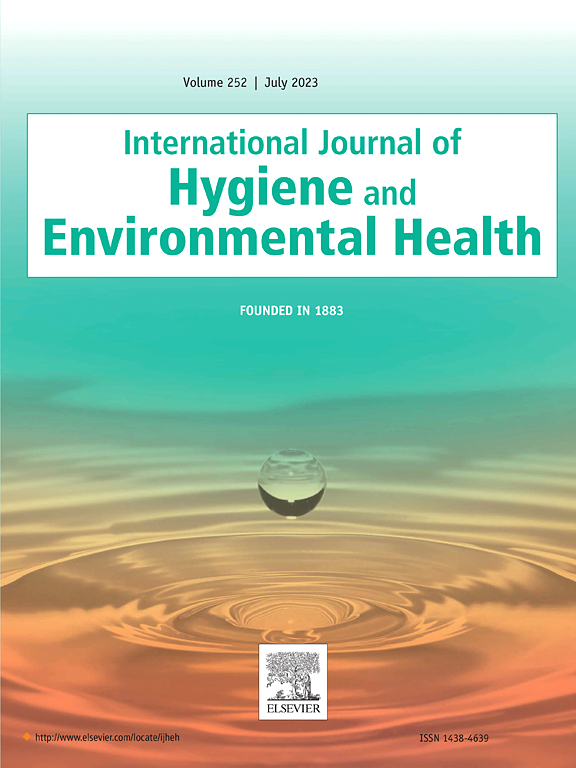丹麦消防部门和武装部队男子的全氟烷基和多氟烷基物质(PFAS)血清浓度。
IF 4.4
2区 医学
Q1 INFECTIOUS DISEASES
International journal of hygiene and environmental health
Pub Date : 2025-06-01
DOI:10.1016/j.ijheh.2025.114559
引用次数: 0
摘要
背景:全氟和多氟烷基物质(PFAS)已广泛用于消防泡沫,导致消防员的职业暴露。目的:检测来自丹麦消防部门和武装部队的现役和退役在职和志愿消防员的血清PFAS浓度。方法:在2023-2024年期间,来自丹麦消防部门和武装部队的429名男性参与了这项研究。他们被要求提供血液样本并填写一份在线问卷。测定血清中15种PFAS的浓度。从2021年抽样的一般人群(enforcement研究)的测量结果作为参考。使用多元线性回归评估职业因素与血清PFAS之间的关系。结果:参与者来自市政消防部门(n = 208)、政府消防部门(n = 59)、民用机场消防部门(n = 50)、空军(n = 98)和海军(n = 14)。他们的中位年龄为50岁,中位入职年份为1999年。虽然大多数参与者的全氟磺酸血清浓度与一般人群相同,但民用机场消防员的全氟己烷磺酸(PFHxS)、全氟庚烷磺酸(PFHpS)和全氟辛烷磺酸(PFOS)的血清浓度更高。民用机场消防员PFHxS、PFHpS和总PFOS的年龄校正几何平均值分别为1.42 ng/mL、0.28 ng/mL和6.92 ng/mL。结论:民用机场消防员血清PFHxS、PFHpS和PFOS浓度较高可能反映了过去职业暴露于消防泡沫。调查结果强调了管制措施和替代的重要性。本文章由计算机程序翻译,如有差异,请以英文原文为准。
Serum concentrations of per- and polyfluoroalkyl substances (PFAS) among men from the Danish fire services and Armed Forces
Background
Per- and polyfluoralkyl substances (PFAS) have been used extensively in firefighting foams with resulting occupational exposure among firefighters.
Objective
To examine serum concentrations of PFAS among current and former employed and volunteer firefighters from the Danish fire services and Armed Forces.
Methods
During 2023–2024, 429 men from the Danish fire services and Armed Forces participated in the study. They were asked to provide a blood sample and fill in an online questionnaire. Concentrations of 15 PFAS were measured in serum. Measurements from the general population sampled in 2021 (the ENFORCE study) were used as reference. Associations between occupational factors and serum PFAS were assessed using multiple linear regression.
Results
Participants were from municipal fire services (n = 208), governmental fire services (n = 59), civilian airport fire services (n = 50), the air force (n = 98) and the navy (n = 14). Their median age was 50 years and median year of commencing service was 1999. While serum concentrations of PFAS among most participants were at level with those of the general population, civilian airport firefighters had higher serum concentrations of especially perfluorohexane sulfonic acid (PFHxS), perfluoroheptane sulfonic acid (PFHpS) and perfluorooctane sulfonic acid (PFOS). Age-adjusted geometric means were 1.42 ng/mL for PFHxS, 0.28 ng/mL for PFHpS and 6.92 ng/mL for total PFOS among civilian airport firefighters.
Conclusion
Higher serum concentrations of PFHxS, PFHpS and PFOS among civilian airport firefighters likely reflected past occupational exposure to firefighting foam. Findings emphasized the importance of regulatory measures and substitution.
求助全文
通过发布文献求助,成功后即可免费获取论文全文。
去求助
来源期刊
CiteScore
11.50
自引率
5.00%
发文量
151
审稿时长
22 days
期刊介绍:
The International Journal of Hygiene and Environmental Health serves as a multidisciplinary forum for original reports on exposure assessment and the reactions to and consequences of human exposure to the biological, chemical, and physical environment. Research reports, short communications, reviews, scientific comments, technical notes, and editorials will be peer-reviewed before acceptance for publication. Priority will be given to articles on epidemiological aspects of environmental toxicology, health risk assessments, susceptible (sub) populations, sanitation and clean water, human biomonitoring, environmental medicine, and public health aspects of exposure-related outcomes.

 求助内容:
求助内容: 应助结果提醒方式:
应助结果提醒方式:


